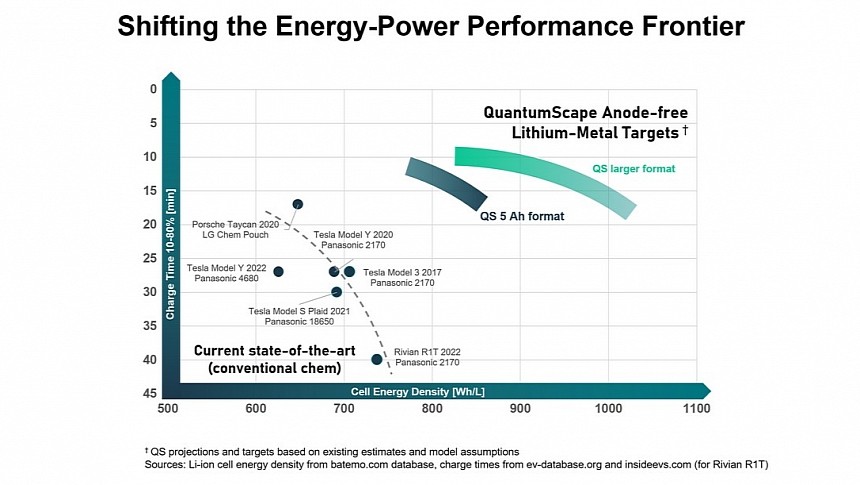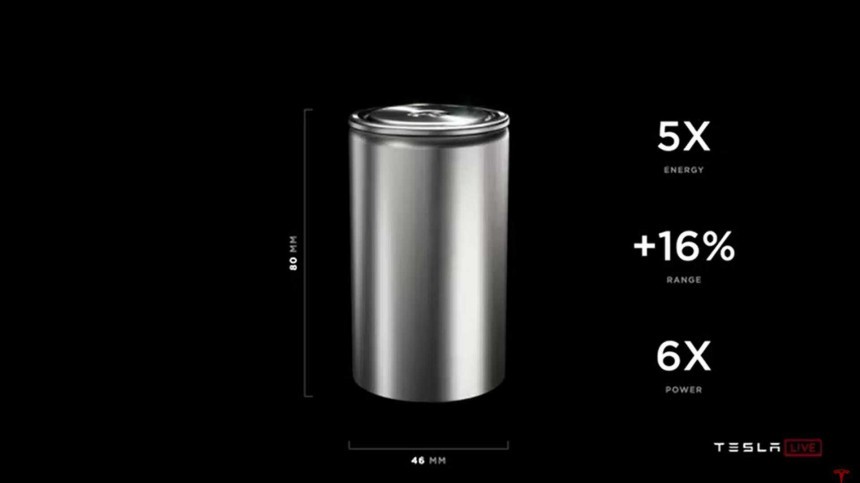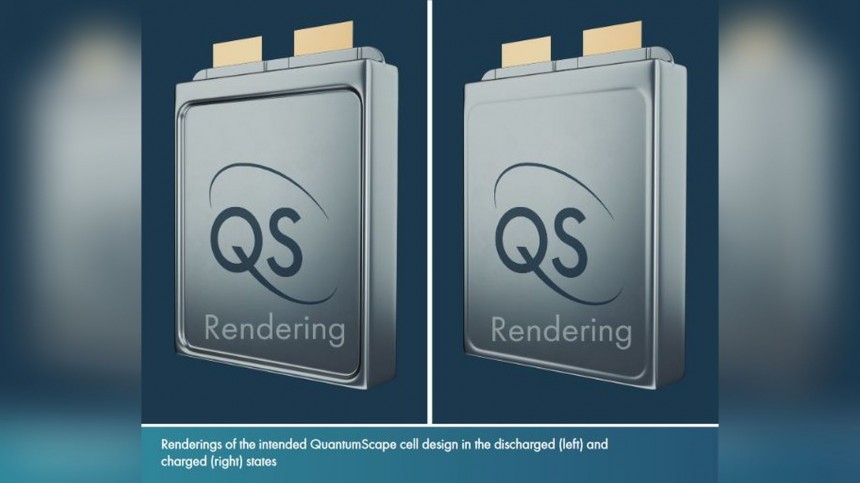Until very recently, QuantumScape only talked about the commercial presentation of its first cell as a target. That changed in its last letter to shareholders, which was about Q2 2023 results. We now have a name for the first solid-state platform's product QuantumScape will offer: it will be called QSE-5. The battery startup also said it already has its first prospective launch customer. Volkswagen, anyone?
The German carmaker would be an obvious choice. It is an early investor in QuantumScape, providing it with money and validation among the myriad of startups that promise to make battery electric vehicles (BEVs) minimally convenient for frequent drivers and people on road trips. The QSE-5 should present a volumetric energy density above 800 Wh/l and a 10% to 80% fast charge in 15 minutes – if an adequate charger for that is available, mind you.
QuantumScape created a graphic (main image) to compare this new battery to the best ones currently in the market, and it helps us visualize how superior the QSE-5 promises to be. Despite an error in one of them and some other stuff the graphic made us wonder about, it seems pretty accurate.
The error happens when it talks about a 2022 Model Y with 4680 cells. QuantumScape states these batteries are made by Panasonic. That is not the case: Tesla manufactures them. Panasonic said it will only make 4680 cells for Tesla in 2023, but we are yet to hear when that will begin. The accurate part of the graphic about these batteries is that they are the worst ones available in terms of energy density.
The BEV maker recently said the Cybertruck would have second-generation 4680 cells with 10% more energy density. If that is true, they will only achieve the same energy density as the 2170 batteries made by Panasonic. It would not surprise me if the "Cybercells" were made by the Japanese company. With the waiting line Tesla has for its electric pickup truck, it will have to purchase batteries from anyone willing to sell them.
In the other extreme of energy density, the closest one to what QuantumScape wants to sell is the 2170 cell Rivian buys from Panasonic: it presents slightly less than 750 Wh/l. The QuantumScape QSE-5 is targeting 800 Wh/l, which does not seem that much. Maybe that is the reason for the battery startup to present its numbers in a range, not in a single point. The maximum energy density for that form factor is 850 Wh/l. The company is also working on a more prominent form factor that will charge faster and present more energy density. The graphic suggests times between 10 and 15 minutes and a volumetric energy density between 850 Wh/l and a bit more than 1,000 Wh/l.
The charging time for the QSE-5 to go from 10% to 80% capacity should be around 15 minutes. Most BEVs spend almost twice as much time on a charger. Rivian fares badly in that regard because it has a massive battery pack, which leads us to wonder how fair it is to compare the performance of some cells in vehicles with something QuantumScape is yet to deliver. The company recently made a webinar to talk about that. It considers that battery makers have to choose between lower energy density and higher charging speeds or higher energy density and slower charging sessions. But there is more to it than the solid-state cell startup disclosed there.
The Taycan appears in the graphic as having one of the best cells for fast charging. That is not correct: the electric Porsche charges fast because it works at 800V, while all the other vehicles in the graphic work at 400V or less. The higher the voltage, the faster charging can be. The larger they are, the more energy they store, hence the longer time for them to charge. In other words, the graphic has substantial distortions that QuantumScape did not care to contextualize. The most pressing questions are at which voltage it can deliver a fast recharge from 10% to 80% in 15 minutes and if that time also applies to a 100-kWh battery pack or only relates to what it can achieve at the cell level.
The graphic also shows that energy density will be higher but not as higher as some people could expect. QuantumScape always talks about volumetric energy density, which is probably the most beneficial measure for its cells. If it spoke about gravimetric energy density, the QSE-5 advantage would likely look even narrower. Without a chemistry breakthrough for these cells to have higher-loading cathodes, solid-state cells' primary advantage is reducing charging times, with a slight edge on weight. With QuantumScape's first prospective launch customer, we'll probably learn more about that when Volkswagen is ready to launch its car with solid-state cells. Sure, it can be another automaker – QuantumScape has quite a few automotive clients – but I seriously doubt it.
QuantumScape created a graphic (main image) to compare this new battery to the best ones currently in the market, and it helps us visualize how superior the QSE-5 promises to be. Despite an error in one of them and some other stuff the graphic made us wonder about, it seems pretty accurate.
The error happens when it talks about a 2022 Model Y with 4680 cells. QuantumScape states these batteries are made by Panasonic. That is not the case: Tesla manufactures them. Panasonic said it will only make 4680 cells for Tesla in 2023, but we are yet to hear when that will begin. The accurate part of the graphic about these batteries is that they are the worst ones available in terms of energy density.
In the other extreme of energy density, the closest one to what QuantumScape wants to sell is the 2170 cell Rivian buys from Panasonic: it presents slightly less than 750 Wh/l. The QuantumScape QSE-5 is targeting 800 Wh/l, which does not seem that much. Maybe that is the reason for the battery startup to present its numbers in a range, not in a single point. The maximum energy density for that form factor is 850 Wh/l. The company is also working on a more prominent form factor that will charge faster and present more energy density. The graphic suggests times between 10 and 15 minutes and a volumetric energy density between 850 Wh/l and a bit more than 1,000 Wh/l.
The charging time for the QSE-5 to go from 10% to 80% capacity should be around 15 minutes. Most BEVs spend almost twice as much time on a charger. Rivian fares badly in that regard because it has a massive battery pack, which leads us to wonder how fair it is to compare the performance of some cells in vehicles with something QuantumScape is yet to deliver. The company recently made a webinar to talk about that. It considers that battery makers have to choose between lower energy density and higher charging speeds or higher energy density and slower charging sessions. But there is more to it than the solid-state cell startup disclosed there.
The graphic also shows that energy density will be higher but not as higher as some people could expect. QuantumScape always talks about volumetric energy density, which is probably the most beneficial measure for its cells. If it spoke about gravimetric energy density, the QSE-5 advantage would likely look even narrower. Without a chemistry breakthrough for these cells to have higher-loading cathodes, solid-state cells' primary advantage is reducing charging times, with a slight edge on weight. With QuantumScape's first prospective launch customer, we'll probably learn more about that when Volkswagen is ready to launch its car with solid-state cells. Sure, it can be another automaker – QuantumScape has quite a few automotive clients – but I seriously doubt it.




















